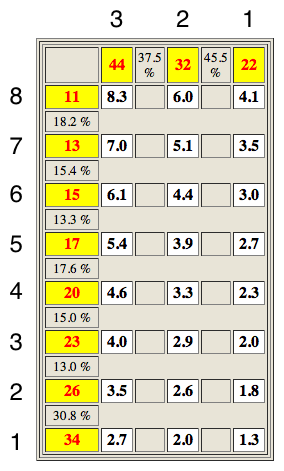Gear Ratios
I know from experience that my bike has a few different gear combinations that yield very similar mechanical advantages. Sheldon Brown’s authoritative bike website features a gear calculator, which inspired me to examine my sprockets so I could calculate the exact gear ratios at my disposal.
My bike has 26″ wheels. In the front, my biggest chainring (high gear) has 44 teeth and the smallest chainring (low gear) has 22 teeth. In the back, I have an 8 speed cluster, ranging from 34 teeth (low gear) to 11 teeth (high gear). Here’s what this information looks like when plugged in to the calculator:


The output is a table of every gear combination. There are a few units to choose from. I like meters development: how many meters the bike will roll forward for each revolution of the pedals. Here’s the table, labeled with front gears across the top and rear gears down the side:
What this shows is that in my highest gear (the most teeth driving the fewest teeth) the bike will go forward 8.3 meters for each revolution of the pedals, whereas in my lowest gear one revolution of the pedals will move the bike forward just 1.3 meters – albeit with enough torque to climb a wall, given sufficiently grippy tires.
Certain sprocket combinations aren’t practical. Generally speaking, I only use high gear in front with high gear in back (top left of the table), and low gear in front with low gear in back (bottom right of the table). Otherwise, the chainline crosses from left to right, or vice versa, which causes more wear and tear; it can also be difficult to shift into these gears. Fortunately, similar ratios to these extremes are available using the middle chainring.
Posted on Saturday, May 29th, 2010. Tags: bike.